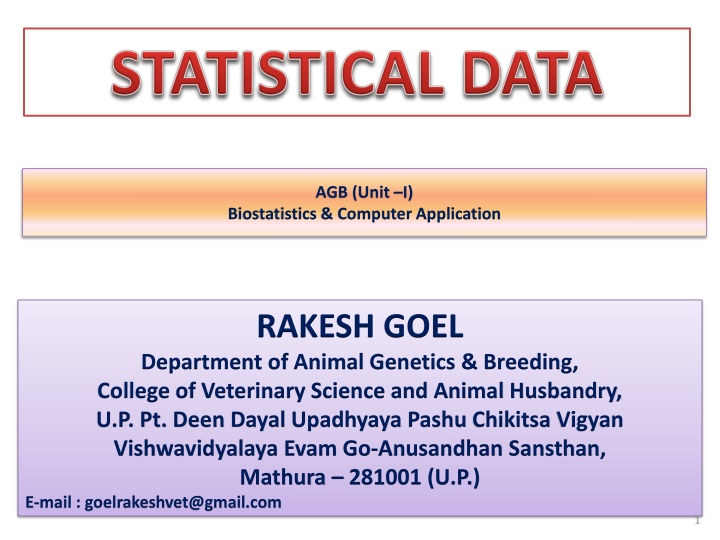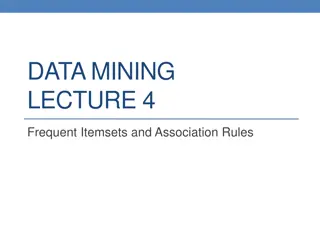RAKESH GOEL
Biostatistics and computer applications play a crucial role in the field of animal genetics and breeding. Statistical series, types of data, collection methods, and data classification are fundamental concepts covered in this domain. Primary and secondary data sources, along with the role of investigators and questionnaires, are essential components of statistical investigations in this area.
Download Presentation

Please find below an Image/Link to download the presentation.
The content on the website is provided AS IS for your information and personal use only. It may not be sold, licensed, or shared on other websites without obtaining consent from the author.If you encounter any issues during the download, it is possible that the publisher has removed the file from their server.
You are allowed to download the files provided on this website for personal or commercial use, subject to the condition that they are used lawfully. All files are the property of their respective owners.
The content on the website is provided AS IS for your information and personal use only. It may not be sold, licensed, or shared on other websites without obtaining consent from the author.
E N D
Presentation Transcript
AGB (Unit I) Biostatistics & Computer Application RAKESH GOEL Department of Animal Genetics & Breeding, College of Veterinary Science and Animal Husbandry, U.P. Pt. Deen Dayal Upadhyaya Pashu Chikitsa Vigyan Vishwavidyalaya Evam Go-Anusandhan Sansthan, Mathura 281001 (U.P.) E-mail : goelrakeshvet@gmail.com 1
Statistical Series When observations of any characteristics present in the individual of a group are recorded and arranged one after the other in a systematic order they form a series known as Statistical series. There are four types of series- (a) Discrete series (b) Continuous series (c) Array series (d) Special series (a) Discrete Series: In discrete series has whole number of counting. For Example: number of students in a class.
(b) Continuous series: In continuous series measures in decimals. For Example: milk yield of 10 cows. (c)Array series: When we arranged the observations of a series either in ascending order of their magnitude or in descending order of their magnitude, then it becomes an array series. (d) Special series: When items of a series are given according to space, then such type of series is known as special series. For Example: month wise attendance of a class. Data The facts and figures collected, analyzed, and summarized for presentation and interpretation.
Collection of data constitutes the first step in statistical investigation. Statistical data are classified under two categories: Primary data: The data which are recorded at the source is known as original data for the Primary data. Actually primary data are those which have never be utilized before. e.g., Daily milk yield recorded at the dairy farm, Commodities of ration issue to animals, etc. Secondary data: Any statistical method is applied on primary data, then, it becomes the Secondary data. e.g., Total of monthly milk yield in the dairy farm, total expenditure, total income, etc.
In a statistical investigation the main requirements are: Investigator or surveyor or enumerator Survey schedule or prescribed Performa Questionnaire The investigator visit the different house-hold selected for study and record the desired data on the prescribed Performa. These data are recorded by putting direct question to the head of the family. In this way, this information recorded on the Performa is known as Primary data. When all such Performa are collected and analyzed statistically i.e. total, average, percentage or other statistical quantity are worked-out, they will be called as Secondary data. The other sources of secondary data are news bulletins, magazine, Annual Progress Reports, radio and T.V., etc.
The arrangement of dividing the huge data in different groups or classes according to resemblances and similarities is known as Classification of data. Statistical data are classified in respect of their characteristics. Broadly, there are four basic types of classification namely- Chronological Classification: Collected data are arranged according to the order of time expressed in years, months, weeks, etc. The data is generally classified in ascending order of time. Geographical or Special Classification: Classification of the data are classified according to geographical region or place. e.g., District wise milk production in Uttar Pradesh. Qualitative Classification: Classification of the data are classified on the basis of some attributes or qualities like: sex, literacy, breed, etc. Quantitative Classification: Classification of data are grouped with reference to characteristic which can be measured and numerically described such as- height, weight, age, etc.
On the basis of these two types (Qualitative and Quantitative) of characteristic the classification may be categorized as- Classification according to attribute: When the given data possess the qualitative characteristic its classification is known as Classification according to attribute. This type of classification may further be divided into two types- Simple Classification: When Classification is done with respect to one qualitative characteristic. e.g, Division of population on the basis of sex i.e. male and female. Manifold Classification: The classification, where two or more attributes are considered and several classes are formed. e.g., Division of population first on the basis of sex then further sub- division on the basis of literacy. Classification according to Class-interval: When the collected data belong to numerical characteristics, e.g. age, weight, then it is grouped into a limited number of class intervals. For this, the difference between these two extreme values, called as 'Range' is divided by the number of groups or classes, we get the value of a class width or class-interval.
Guidelines for Selecting Width of Classes Use classes of equal width Approximate Class Width Range = Class interval Number of Classes Guidelines for Selecting Number of Classes Use between 5 and 20 classes. Data sets with a larger number of elements usually require a larger number of classes Smaller data sets usually require fewer classes
FREQUENCY DISTRIBUTION A frequency distribution is defined as the way in which the original data are divided into un-differential class interval and it contains in first column, the class intervals and in the second column corresponding frequencies. It is also known as Frequency table. Cumulative frequencies are also included then the table is known as Cumulative frequency table. The objective is to provide insights about the data that cannot be quickly obtained by looking only at the original data.
When we form different class intervals, then each class interval has two values, the lower value is known as the Lower limit of the class-interval while the upper value is known as the Upper limit of the class-interval. Each class-interval has two limits and for making class-interval there are two methods- Inclusive method: In this method, upper limit of the class-interval is not taken equal to lower limit of the next class-interval. It means, there is always gap between them. e.g, a-b, c-d, e-f, . In this case, both lower and upper limits are included in the same class intervals. Exclusive method: In this method, the upper limit of the class-interval is taken equal to lower limit of the next higher class-interval. It means, there is no gap between the upper limit of the first class-interval and the lower limit of the second class-interval. e.g., a-b, b-c, In this case, the values equal to upper limit of a class-interval are not taken in the same class intervals but they are taken under the next higher class-interval.
TRUE OR ACTUAL CLASS LIMITS Division of given data considering the magnitude are put against different class in the form of Tally mark (/). The four tally marks are put parallel to each other and fifth one cross the four (////). This is done actually to facility the counting of like: animals, articles, persons, etc. The total number of tally marks against a class is known as frequency of that class and this is known as frequency distribution'. The tabular form of a frequency distribution is called a 'frequency table'. These are two types of frequency tables- Simple frequency table: In this table, the first column of table contains values of class intervals and second column come their simple frequency. Cumulative frequency table: When frequencies are sum up then they are known as 'Cumulative Frequency'. There are two types of cumulative frequencies- Less than cumulative frequency: By adding the frequencies of all observations less than the upper class boundary of a given class, we get 'Less than cumulative frequency'. More than cumulative frequency: On adding the frequencies of all observations more than the lower class boundary, one gets 'More than cumulative frequency'.
The presentation of classified data in a suitable tabular form is known as Tabulation of data . In other words, tabulation may be defined as the arrangement of data in different rows and columns. The tabulation is always done after classification only and more over tabulation is not a statistical process but it is simply a mechanical process. In other words, tabulation may be defined as the arrangement of data in different rows and columns. The tabulation is always done after classification only.
The tabulation is classified as follows- Simple tabulation: When sub-division of total data is done on the basis of one factor then it is called Simple tabulation. It can provide answer of one question only. e.g., Division of livestock population on the basis of different states. Complex tabulation: It is further sub-divided in three types- Double tabulation: When sub-division of total data is done on the basis of two factor then it is called Double tabulation. It can provide answer of two questions. e.g., Division of livestock population first on the basis of states then further sub-division on the basis of species.
Triple tabulation: When sub-division of total data is done on the basis of three factor then it is called Triple tabulation. It can provide answer of three questions. e.g., Division of livestock population first on the basis of states, second on the basis of species and third on the basis of sex. Manifold tabulation: When sub-division of total data is done on the basis of more than three factors then it is called Manifold tabulation. e.g., Division of livestock population first on the basis of states, second on the basis of species, third on the basis of sex and fourth on the basis of maturity i.e. young and adult. The tabulation is always done after classification only and more over tabulation is not a statistical process but, it is simply a mechanical process.























